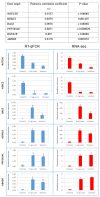Deregulation of Biologically Significant Genes and Associated Molecular Pathways in the Oral Epithelium of Electronic Cigarette Users
- PMID: 30744164
- PMCID: PMC6386888
- DOI: 10.3390/ijms20030738
Deregulation of Biologically Significant Genes and Associated Molecular Pathways in the Oral Epithelium of Electronic Cigarette Users
Abstract
We have investigated the regulation of genes and associated molecular pathways, genome-wide, in oral cells of electronic cigarette (e-cigs) users and cigarette smokers as compared to non-smokers. Interrogation of the oral transcriptome by RNA-sequencing (RNA-seq) analysis showed significant number of aberrantly expressed transcripts in both e-cig users (vapers) and smokers relative to non-smokers; however, smokers had ~50% more differentially expressed transcripts than vapers (1726 versus 1152). Whereas the deregulated transcripts in smokers were predominately from protein-coding genes (79% versus 53% in vapers), nearly 28% of the aberrantly expressed transcripts in vapers (versus 8% in smokers) belonged to regulatory non-coding RNAs, including long intergenic non-coding, antisense, small nucleolar and misc RNA (P < 0.0001). Molecular pathway and functional network analyses revealed that "cancer" was the top disease associated with the deregulated genes in both e-cig users and smokers (~62% versus 79%). Examination of the canonical pathways and networks modulated in either e-cig users or smokers identified the "Wnt/Ca⁺ pathway" in vapers and the "integrin signaling pathway" in smokers as the most affected pathways. Amongst the overlapping functional pathways impacted in both e-cig users and smokers, the "Rho family GTPases signaling pathway" was the top disrupted pathway, although the number of affected targets was three times higher in smokers than vapers. In conclusion, we observed deregulation of critically important genes and associated molecular pathways in the oral epithelium of vapers that bears both resemblances and differences with that of smokers. Our findings have significant implications for public health and tobacco regulatory science.
Keywords: RNA-seq; carcinogenesis; gene regulation; transcription; vaping.
Conflict of interest statement
The authors declare no conflict of interest. The sponsors of the study had no role in study design, data collection, data analysis, data interpretation, writing of the report, or in the decision to submit for publication.
Figures







References
-
- Schoenborn C.A., Gindi R.M. Electronic Cigarette Use Among Adults: United States. Department of Health and Human Services, Centers for Disease Control and Prevention, National Center for Health Statistics; Atlanta, GA, USA: 2014. pp. 1–8.
MeSH terms
Grants and funding
LinkOut - more resources
Full Text Sources
Medical
Molecular Biology Databases

